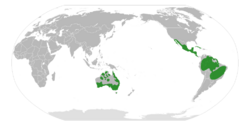Biology:Brongniartieae
| Brongniartieae | |
|---|---|

| |
| Templetonia retusa | |
| Scientific classification | |
| Kingdom: | Plantae |
| Clade: | Tracheophytes |
| Clade: | Angiosperms |
| Clade: | Eudicots |
| Clade: | Rosids |
| Order: | Fabales |
| Family: | Fabaceae |
| Subfamily: | Faboideae |
| Clade: | Meso-Papilionoideae |
| Clade: | Genistoids |
| Tribe: | Brongniartieae (Benth.) Ross and Crisp[1][2] |
| Genera[6][7] | |
| |

| |
| Range of the Brongniartieae | |
| Synonyms[8] | |
| |
The tribe Brongniartieae is one of the subdivisions of the plant family Fabaceae, primarily found in tropical regions of the Americas and in Australia [9] The members of this tribe consistently form a monophyletic clade in molecular phylogenetic analyses.[7][10][11][12][13][14][15][16][17][18] The tribe does not currently have a node-based definition, but morphological synapomorphies have been identified:
"stamens united by filaments in an adaxially open tube; anthers alternately long and basifixed, short and versatile; anther connective inconspicuous; septa present between seeds in pods; aril lateral lobe present and fitting into heel of funicle; fine red glandular processes present in axils; and pollen tricolporate with opercula and no definite endoaperture."[7][9][19]
References
- ↑ "Brongniartieae". Legumes of the World. Royal Botanic Gardens, Kew. 2005. pp. 253–259. ISBN 978-1900347808. http://www.kewbooks.com/asps/ShowDetails.asp?id=506.
- ↑ Wojciechowski MF (2013). "Towards a new classification of Leguminosae: Naming clades using non-Linnaean phylogenetic nomenclature". S Afr J Bot 89: 85–93. doi:10.1016/j.sajb.2013.06.017.
- ↑ "A molecular phylogeny reveals the Cuban enigmatic genus Behaimia as a new piece in the Brongniartieae puzzle of papilionoid legumes". Molecular Phylogenetics and Evolution 109: 191–202. 2017. doi:10.1016/j.ympev.2017.01.001. PMID 28089794.
- ↑ "A phylogenetic analysis of molecular and morphological data reveals a paraphyletic Poecilanthe (Leguminosae, Papilionoideae)". Syst Bot 39 (4): 1142–1149. 2014. doi:10.1600/036364414X683912.
- ↑ "Limadendron: a new genus of Leguminosae (Papilionoideae, Brongniartieae) from South America". Plant Syst Evol 301 (2): 701–707. 2014. doi:10.1007/s00606-014-1108-7.
- ↑ "Tabaroa, a new genus of Leguminosae tribe Brongniartieae from Brazil". Kew Bull 65 (2): 189–203. 2010. doi:10.1007/s12225-010-9202-7.
- ↑ 7.0 7.1 7.2 "Reconstructing the deep-branching relationships of the papilionoid legumes". S Afr J Bot 89: 58–75. 2013. doi:10.1016/j.sajb.2013.05.001.
- ↑ "Kew Royal Botanic Gardens entry for Brongniartieae". Royal Botanic Gardens, Kew. 23 July 2013. http://www.kew.org/science-research-data/lowo/TaxonomicView/SubFamily/Tribe/index.htm?kew_lowo_accepted_name_path=Brongniartieae.
- ↑ 9.0 9.1 "Phylogenetic studies of the tribe Brongniartieae (Fabaceae) using nuclear DNA (ITS-1) and morphological data". Syst Bot 26 (3): 557–570. 2001. doi:10.1043/0363-6445-26.3.557. http://www.bioone.org/doi/abs/10.1043/0363-6445-26.3.557.
- ↑ "Phylogenetic analysis of nuclear ribosomal ITS/5.85 sequences in the tribe Millettieae (Fabaceae): Poecilanthe–Cyclolobium, the core Millettieae, and the Callerya group". Syst Bot 27 (4): 722–733. 2002. doi:10.1043/0363-6445-27.4.722. http://www.bioone.org/doi/abs/10.1043/0363-6445-27.4.722.
- ↑ "Revisiting the phylogeny of papilionoid legumes: new insights from comprehensively sampled early-branching lineages". Am J Bot 99 (12): 1991–2013. 2012. doi:10.3732/ajb.1200380. PMID 23221500.
- ↑ "A phylogeny of legumes (Leguminosae) based on analysis of the plastid matK gene resolves many well-supported subclades within the family". Am J Bot 91 (11): 1846–1862. 2004. doi:10.3732/ajb.91.11.1846. PMID 21652332.
- ↑ "Evolution of chemical defense traits in the Leguminosae: mapping of distribution patterns of secondary metabolites on a molecular phylogeny inferred from nucleotide sequences of the rbcL gene". Biochem Syst Ecol 31 (8): 897–917. 2003. doi:10.1016/S0305-1978(03)00085-1.
- ↑ "Phylogenetic relationships of basal papilionoid legumes based upon sequences of the chloroplast trnL intron". Syst Bot 55 (5): 818–836. 2001. doi:10.1043/0363-6445-26.3.537. http://www.bioone.org/doi/abs/10.1043/0363-6445-26.3.537.
- ↑ "Molecular phylogeny of the genistoid tribes of papilionoid legumes". Advances in Legume Systematics, Part 9. Royal Botanic Gardens, Kew. 2000. pp. 249–276. ISBN 978-1842460177. http://www.kewbooks.com/asps/ShowDetails.asp?id=52.
- ↑ "Towards a comprehensive phylogeny of legumes: evidence from rbcL sequences and non-molecular data". Advances in Legume Systematics, Part 9. Royal Botanic Gardens, Kew. 2000. pp. 1–20. ISBN 978-1842460177. http://www.kewbooks.com/asps/ShowDetails.asp?id=52.
- ↑ "Evolutionary rates analysis of Leguminosae implicates a rapid diversification of lineages during the tertiary". Syst Biol 54 (4): 575–94. 2005. doi:10.1080/10635150590947131. PMID 16085576.
- ↑ LPWG [Legume Phylogeny Working Group] (2013). "Legume phylogeny and classification in the 21st century: progress, prospects and lessons for other species-rich clades". Taxon 62 (2): 217–248. doi:10.12705/622.8. https://www.zora.uzh.ch/id/eprint/78167/1/Taxon_2013_217-248.pdf.
- ↑ Stirton CH, ed (1987). "Cladistics and legume systematics, with an analysis of the Bossiaeeae, Brongniartieae and Mirbelieae". Advances in Legume Systematics, Part 3. Royal Botanic Gardens, Kew. pp. 65–130. ISBN 978-0947643072. http://www.kewbooks.com/asps/ShowDetails.asp?id=317.
External links
Wikidata ☰ Q4973867 entry
 |

